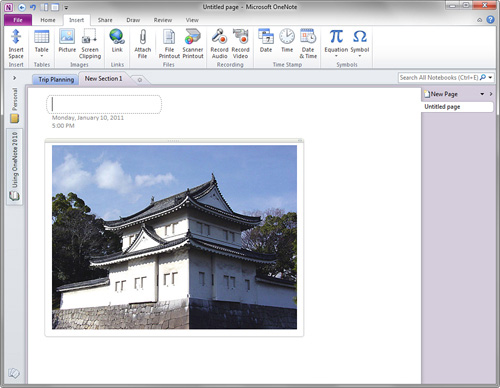Admit it, one of the things that made your
old paper notebook so appealing was the ability to gather a bunch of
handouts, note scraps, scribbles, doodles, and printouts, toss them into
your notebook, and then take it all with you. Sure, it was messy and
unorganized, but at least you had that cozy feeling of having everything
with you—even if it was going to be a time-consuming affair to leaf
through it all and find anything again.
OneNote 2010 does it one better. It matches the
ability of a paper binder to keep everything together and take it all
with you, but it also lets you easily find everything again. With
OneNote, you’ll also never have to worry about one of the scraps of
paper falling out of your notebook.
First things first, though: Take a closer look at the
many ways in which you can collect and import all kinds of information
into your OneNote notebook.
1. Inserting a Picture from a File
Pictures can be placed inside of a notes container or as free-floating objects on any page in OneNote (see Figure 1).

A picture can be any image file that your computer
supports, such as a photo that you’ve taken with your digital camera, a
stock photograph that you’ve purchased on a website, a piece of clip art
that you’ve downloaded, or a screenshot that you’ve captured with your
computer.
2. Inserting Pictures into Notes
Although you can simply copy an image from somewhere
on your computer and then paste it into OneNote, properly inserting the
actual picture file may produce higher-quality results, especially with
pictures that contain text or other kinds of information.
To insert a picture into your notes, follow these steps:
1. | Open or create the page in your notebook where you want to insert a picture.
|
2. | Click
the place on the page where OneNote should place the imported picture. A
blinking cursor will confirm where the picture will be placed.
|
3. | On the Insert tab, in the Images group, click Picture.
|
4. | In the Insert Picture dialog box that opens, navigate to the folder on your computer where the picture file is stored.
|
5. | Click to select the picture you want to insert and then click Insert.
|
OneNote 2010 lets you import a large variety of image file types, including the following:
Joint Photographic Expert Group (.jpg, .jpg, .jpe, .jfif)
Portable Network Graphics (.png)
Graphics Interchange Format (.gif)
Tagged Image File Format (.tif, .tiff)
Encapsulated PostScript (.eps)
Windows Bitmap (.bmp, .dib, .rle)
Windows Metafile (.wmf)
Windows Enhanced Metafile (.emf)
Compressed Windows Enhanced Metafile (.wmz)
Macintosh PICT (.pct, .pict)
Compressed Macintosh PICT (.pcz)
Computer Graphics Metafile (.cgm)
WordPerfect Graphics (.wpg)
|
To import a picture from a web page, use the same
steps as given previously, except in step 4, type or paste the full URL
of the image at its web location into the File name box and then click
Open.
|